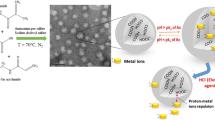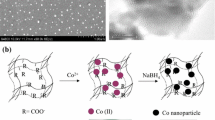Abstract
Resorcinol formaldehyde (RF) xerogel was modified by mercapto functional groups for removal of Pb(II) and Cu(II) ions from aqueous solutions. The chemical structure of the mercapto-modified resorcinol formaldehyde xerogel (MRFX) was compared with the RF xerogel via Fourier transform infrared spectra (FTIR), X-ray photoelectric spectroscopy (XPS), and energy dispersive X-ray (EDX) mapping to characterize the functional groups and their dispersion in the xerogel. The results showed that the MRFX included not only thiol groups, but also sulfonic groups with higher adsorption affinity sites. The functional groups were fully dispersed in the xerogel and made a homogeneous composition. X-ray diffraction (XRD) patterns were also employed to show the effect of modifier on the phase structure of the xerogels. Moreover, the morphologies of the xerogels were observed by scanning electron microscope (SEM) and transmission electron microscopy (TEM) techniques. According to the TEM micrographs, the MRFX included more nanopores than the unmodified xerogel. The MRFX was studied for adsorption tests. According to the results, the optimal pH to adsorb maximum Pb(II) and Cu(II) ions was 6. Adsorption kinetics study revealed that the adsorption process followed the pseudo-second-order kinetic equations and the adsorption equilibrium agreed much more with Langmuir rather than Freundlich model.

Resorcinol formaldehyde xerogel was modified by mercaptopropyl–trimethoxysilane during a sol–gel process. After the aging step, the wet gel was treated with pure acetone to exchange the pore liquid. As a result, the porosity of the xerogel was not terminated after drying. The xerogel was then used to adsorb Cu(II) and Pb(II) ions from aqueous solutions. According to the results, thiol and sulfonic groups were the major active sites with high adsorption affinities in the adsorption process.
Highlights
-
MRFX was used in the removal of Pb(II) and Cu(II) ions from aqueous solutions.
-
MRFX included not only thiol groups, but also sulfonic groups with higher adsorption affinity sites.
-
Adsorption isotherms and kinetics were used to address the adsorption mechanism.
-
The adsorption capacities of Pb(II) and Cu(II) are 84 and 120 mg g−1, respectively.









Similar content being viewed by others
References
Zhao J, Liu J, Li N, Wang W, Nan J, Zhao Z, Cui F (2016) Highly efficient removal of bivalent heavy metals from aqueous systems by magnetic porous Fe 3 O 4-MnO 2: adsorption behavior and process study. Chem Eng J 304:737–746
Štandeker S, Veronovski A, Novak Z, Knez Ž (2011) Silica aerogels modified with mercapto functional groups used for Cu (II) and Hg (II) removal from aqueous solutions. Desalination 269(1):223–230
Fu F, Wang Q (2011) Removal of heavy metal ions from wastewaters: a review. J Environ Manag 92(3):407–418
Jal P, Patel S, Mishra B (2004) Chemical modification of silica surface by immobilization of functional groups for extractive concentration of metal ions. Talanta 62(5):1005–1028
Liu C, Bai R, San Ly Q (2008) Selective removal of copper and lead ions by diethylenetriamine-functionalized adsorbent: behaviors and mechanisms. Water Res 42(6):1511–1522
Javadian H, Taghavi M (2014) Application of novel polypyrrole/thiol-functionalized zeolite Beta/MCM-41 type mesoporous silica nanocomposite for adsorption of Hg 2 + from aqueous solution and industrial wastewater: kinetic, isotherm and thermodynamic studies. Appl Surf Sci 289:487–494
Hakami O, Zhang Y, Banks CJ (2012) Thiol-functionalised mesoporous silica-coated magnetite nanoparticles for high efficiency removal and recovery of Hg from water. Water Res 46(12):3913–3922
Meena AK, Mishra G, Rai P, Rajagopal C, Nagar P (2005) Removal of heavy metal ions from aqueous solutions using carbon aerogel as an adsorbent. J Hazard Mater 122(1):161–170
Kadirvelu K, Goel J, Rajagopal C (2008) Sorption of lead, mercury and cadmium ions in multi-component system using carbon aerogel as adsorbent. J Hazard Mater 153(1):502–507
Ramadan H, Ghanem A, El-Rassy H (2010) Mercury removal from aqueous solutions using silica, polyacrylamide and hybrid silica–polyacrylamide aerogels. Chem Eng J 159(1):107–115
Faghihian H, Nourmoradi H, Shokouhi M (2012) Performance of silica aerogels modified with amino functional groups in PB (II) and CD (II) removal from aqueous solutions. Pol J Chem Technol 14(1):50–56
Maleki H (2016) Recent advances in aerogels for environmental remediation applications: a review. Chem Eng J 300:98–118
Faghihian H, Nourmoradi H, Shokouhi M (2014) Removal of copper (II) and nickel (II) from aqueous media using silica aerogel modified with amino propyl triethoxysilane as an adsorbent: equilibrium, kinetic, and isotherms study. Desalin Water Treat 52(1-3):305–313
Motahari S, Nodeh M, Maghsoudi K (2016) Absorption of heavy metals using resorcinol formaldehyde aerogel modified with amine groups. Desalin Water Treat 57(36):16886–16897
Motahari S, Heidari BS, Motlagh GH (2015) Resorcinol formaldehyde xerogels modified with mercapto functional groups as mercury adsorbent. J Appl Polym Sci 132(37):42543
Pekala R (1989) Organic aerogels from the polycondensation of resorcinol with formaldehyde. J Mater Sci 24(9):3221–3227
Sing KS (1985) Reporting physisorption data for gas/solid systems with special reference to the determination of surface area and porosity (Recommendations 1984). Pure Appl Chem 57(4):603–619
Velikova N, Vueva Y, Ivanova Y, Salvado I, Fernandes M, Vassileva P, Georgieva R, Detcheva A (2013) Synthesis and characterization of sol–gel mesoporous organosilicas functionalized with amine groups. J NonCryst Solids 378:89–95
Davachi SM, Heidari BS, Hejazi I, Seyfi J, Oliaei E, Farzaneh A, Rashedi H (2017) Interface modified polylactic acid/starch/poly ε-caprolactone antibacterial nanocomposite blends for medical applications. Carbohydr Polym 155:336–344
Davoodi S, Oliaei E, Davachi SM, Hejazi I, Seyfi J, Heidari BS, Ebrahimi H (2016) Preparation and characterization of interface-modified PLA/starch/PCL ternary blends using PLLA/triclosan antibacterial nanoparticles for medical applications. RSC Adv 6(46):39870–39882
Demjen Z, Pukanszky B, Nagy Jr J (1999) Possible coupling reactions of functional silanes and polypropylene. Polym (Guildf) 40(7):1763–1773
Jafari M, Davachi SM, Mohammadi-Rovshandeh J, Pouresmaeel-Selakjani P (2017) Preparation and characterization of bionanocomposites based on benzylated wheat straw and nanoclay. J Polym Environ 17:(9)1–13
Davachi SM, Shekarabi AS (2018) Preparation and characterization of antibacterial, eco-friendly edible nanocomposite films containing Salvia macrosiphon and nanoclay. Int J Biol Macromol 113:66–72
Gwon JG, Lee SY, Doh GH, Kim JH (2010) Characterization of chemically modified wood fibers using FTIR spectroscopy for biocomposites. J Appl Polym Sci 116(6):3212–3219
Idris SA, Harvey SR, Gibson LT (2011) Selective extraction of mercury (II) from water samples using mercapto functionalised-MCM-41 and regeneration of the sorbent using microwave digestion. J Hazard Mater 193:171–176
Wang L, Tian Y, Ding H, Li J (2006) Microstructure and properties of organosoluble polyimide/silica hybrid films. Eur Polym J 42(11):2921–2930
Bhatia QS, Pan DH, Koberstein JT (1988) Preferential surface adsorption in miscible blends of polystyrene and poly (vinyl methyl ether). Macromolecules 21(7):2166–2175
Fu R, Yoshizawa N, Dresselhaus MS, Dresselhaus G, Satcher JH, Baumann TF (2002) XPS study of copper-doped carbon aerogels. Langmuir 18(26):10100–10104
Wu X, Fan M, Shen X, Cui S, Tan G (2018) Silica aerogels formed from soluble silicates and methyl trimethoxysilane (MTMS) using CO2 gas as a gelation agent. Ceram Int 44(1):821–829
Wu F, Li J, Tian Y, Su Y, Wang J, Yang W, Li N, Chen S, Bao L (2015) 3D coral-like nitrogen-sulfur co-doped carbon-sulfur composite for high performance lithium-sulfur batteries. Sci Rep 5:13340
Zhu ZK, Yang Y, Yin J, Qi ZN (1999) Preparation and properties of organosoluble polyimide/silica hybrid materials by sol–gel process. J Appl Polym Sci 73(14):2977–2984
Reiche S, Blume R, Zhao XC, Su D, Kunkes E, Behrens M, Schlögl R (2014) Reactivity of mesoporous carbon against water–An in-situ XPS study. Carbon N Y 77:175–183
Yang WJ, Neoh K-G, Kang E-T, Teo SL-M, Rittschof D (2013) Stainless steel surfaces with thiol-terminated hyperbranched polymers for functionalization via thiol-based chemistry. Polym Chem 4(10):3105–3115
Aslam M, Gopakumar G, Shoba T, Mulla I, Vijayamohanan K, Kulkarni S, Urban J, Vogel W (2002) Formation of Cu and Cu2O nanoparticles by variation of the surface ligand: preparation, structure, and insulating-to-metallic transition. J Colloid Interface Sci 255(1):79–90
Das D, Lee J-F, Cheng S (2004) Selective synthesis of Bisphenol-A over mesoporous MCM silica catalysts functionalized with sulfonic acid groups. J Catal 223(1):152–160
Cano-Serrano E, Blanco-Brieva G, Campos-Martin J, Fierro J (2003) Acid-functionalized amorphous silica by chemical grafting-quantitative oxidation of thiol groups. Langmuir 19(18):7621–7627
van Bergen LA, Roos G, De Proft F (2014) From thiol to sulfonic acid: modeling the oxidation pathway of protein thiols by hydrogen peroxide. J Phys Chem A 118(31):6078–6084
Gomes HT, Miranda SM, Sampaio MJ, Figueiredo JL, Silva AM, Faria JL (2011) The role of activated carbons functionalized with thiol and sulfonic acid groups in catalytic wet peroxide oxidation. Appl Catal B Environ 106(3-4):390–397
Nikiforov AY, Leys C (2007) Influence of capillary geometry and applied voltage on hydrogen peroxide and OH radical formation in ac underwater electrical discharges. Plasma Sources Sci Technol 16(2):273
Oyedoh EA, Albadarin A, Walker G, Mirzaeian M, Ahmad M (2013) Preparation of controlled porosity resorcinol formaldehyde xerogels for adsorption applications. Chem Eng Trans 32:1651–1656
Awadallah-F A, Al-Muhtaseb SA (2013) Influence of micro-and mesoporosity of resorcinol–formaldehyde xerogels on adsorption. Environ Eng Sci 30(7):381–386
Yan H, Jiang L, Xu X, Li Y, Shen Y, Zhu S (2017) Ultrastrong composite film of chitosan and silica-coated graphene oxide sheets. Int J Biol Macromol 104:936–943
Zvinowanda C, Okonkwo J, Shabalala P, Agyei N (2009) A novel adsorbent for heavy metal remediation in aqueous environments. Int J Environ Sci Technol 6(3):425–434
Foo K, Hameed B (2010) Insights into the modeling of adsorption isotherm systems. Chem Eng J 156(1):2–10
Pan S, Shen H, Xu Q, Luo J, Hu M (2012) Surface mercapto engineered magnetic Fe 3 O 4 nanoadsorbent for the removal of mercury from aqueous solutions. J Colloid Interface Sci 365(1):204–212
Jiao C, Xiong J, Tao J, Xu S, Zhang D, Lin H, Chen Y (2016) Sodium alginate/graphene oxide aerogel with enhanced strength–toughness and its heavy metal adsorption study. Int J Biol Macromol 83:133–141
Deze EG, Papageorgiou SK, Favvas EP, Katsaros FK (2012) Porous alginate aerogel beads for effective and rapid heavy metal sorption from aqueous solutions: effect of porosity in Cu 2 + and Cd 2 + ion sorption. Chem Eng J 209:537–546
Qi Y, Wang J, Wang X, Cheng JJ, Wen Z (2017) Selective adsorption of Pb(II) from aqueous solution using porous biosilica extracted from marine diatom biomass: properties and mechanism. Appl Surf Sci 396:965–977. https://doi.org/10.1016/j.apsusc.2016.11.069
Goel J, Kadirvelu K, Rajagopal C, Garg V (2005) Removal of lead (II) from aqueous solution by adsorption on carbon aerogel using a response surface methodological approach. Ind Eng Chem Res 44(7):1987–1994
Author information
Authors and Affiliations
Corresponding author
Ethics declarations
Conflict of interest
The authors declare that they have no conflict of interest.
Rights and permissions
About this article
Cite this article
Heidari, B.S., Cheraghchi, VS., Motahari, S. et al. Optimized mercapto-modified resorcinol formaldehyde xerogel for adsorption of lead and copper ions from aqueous solutions. J Sol-Gel Sci Technol 88, 236–248 (2018). https://doi.org/10.1007/s10971-018-4782-z
Received:
Accepted:
Published:
Issue Date:
DOI: https://doi.org/10.1007/s10971-018-4782-z




